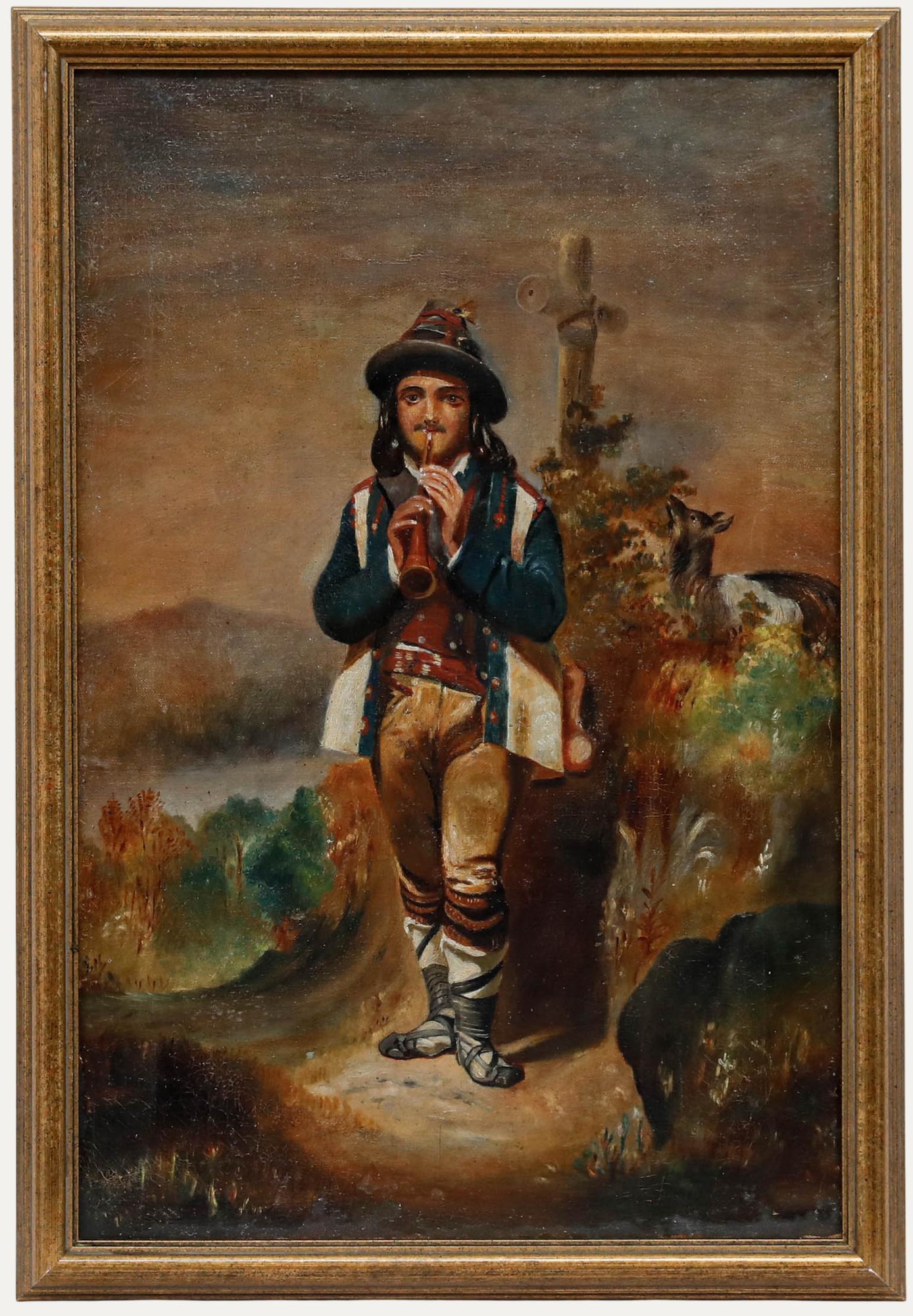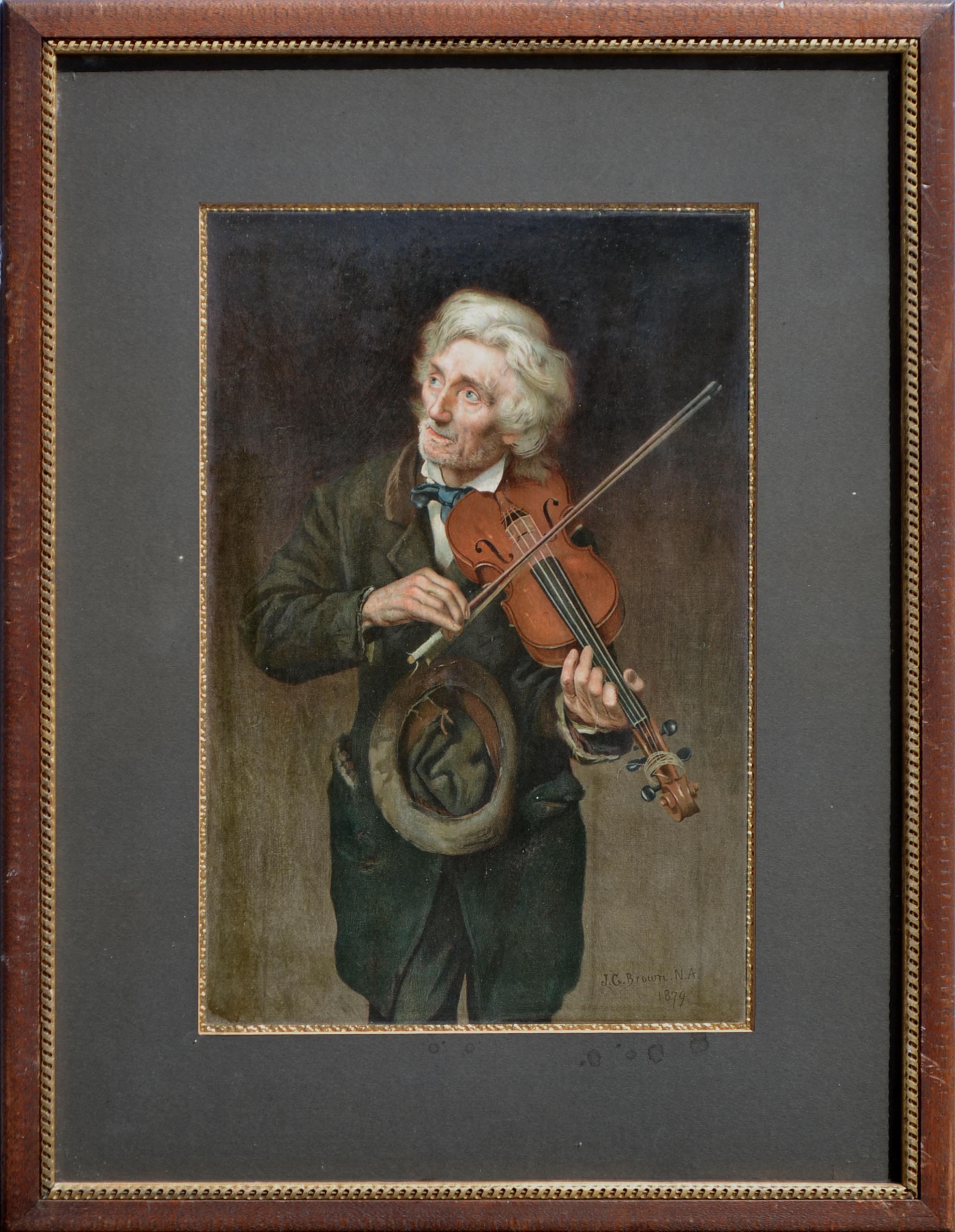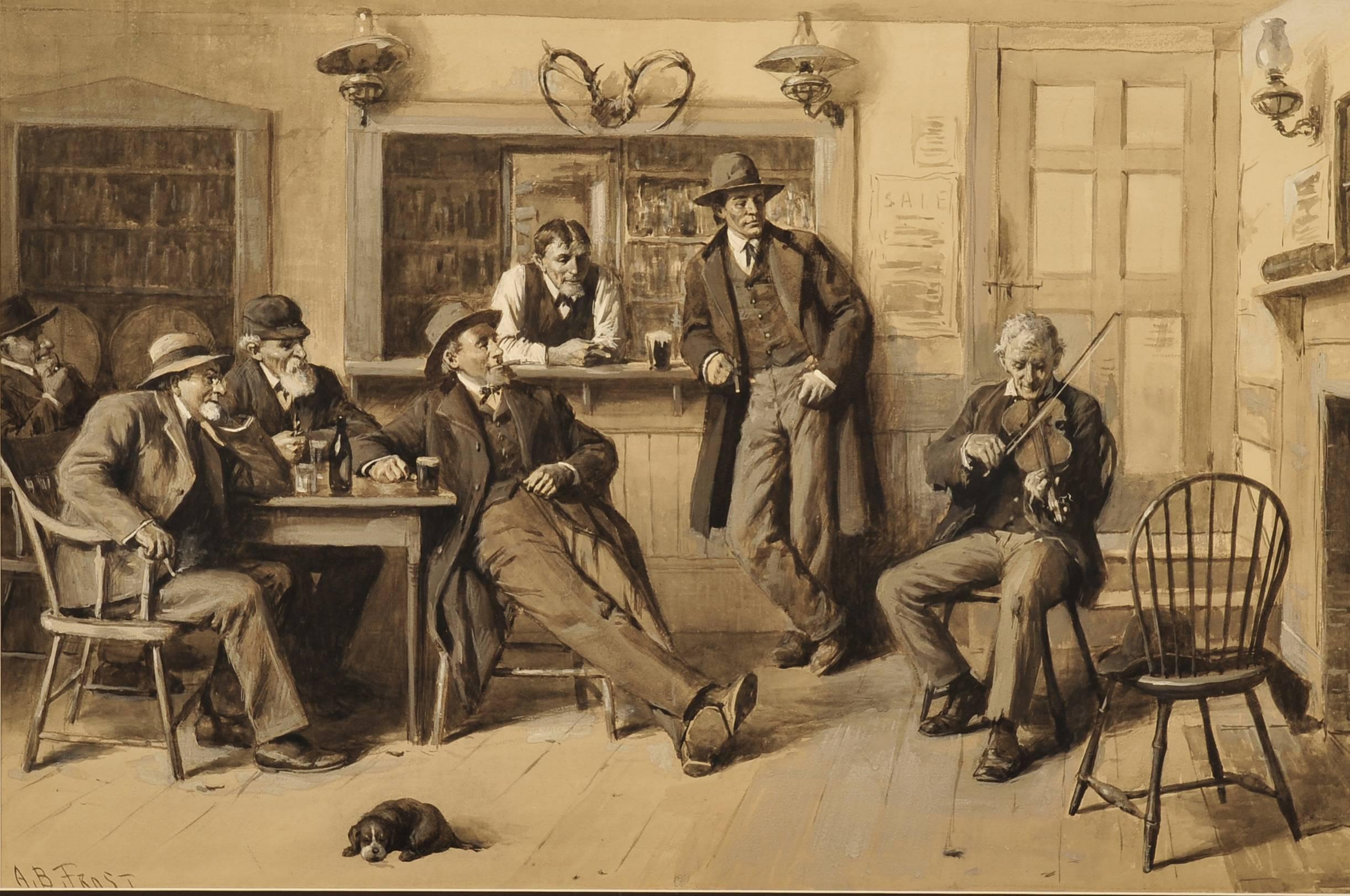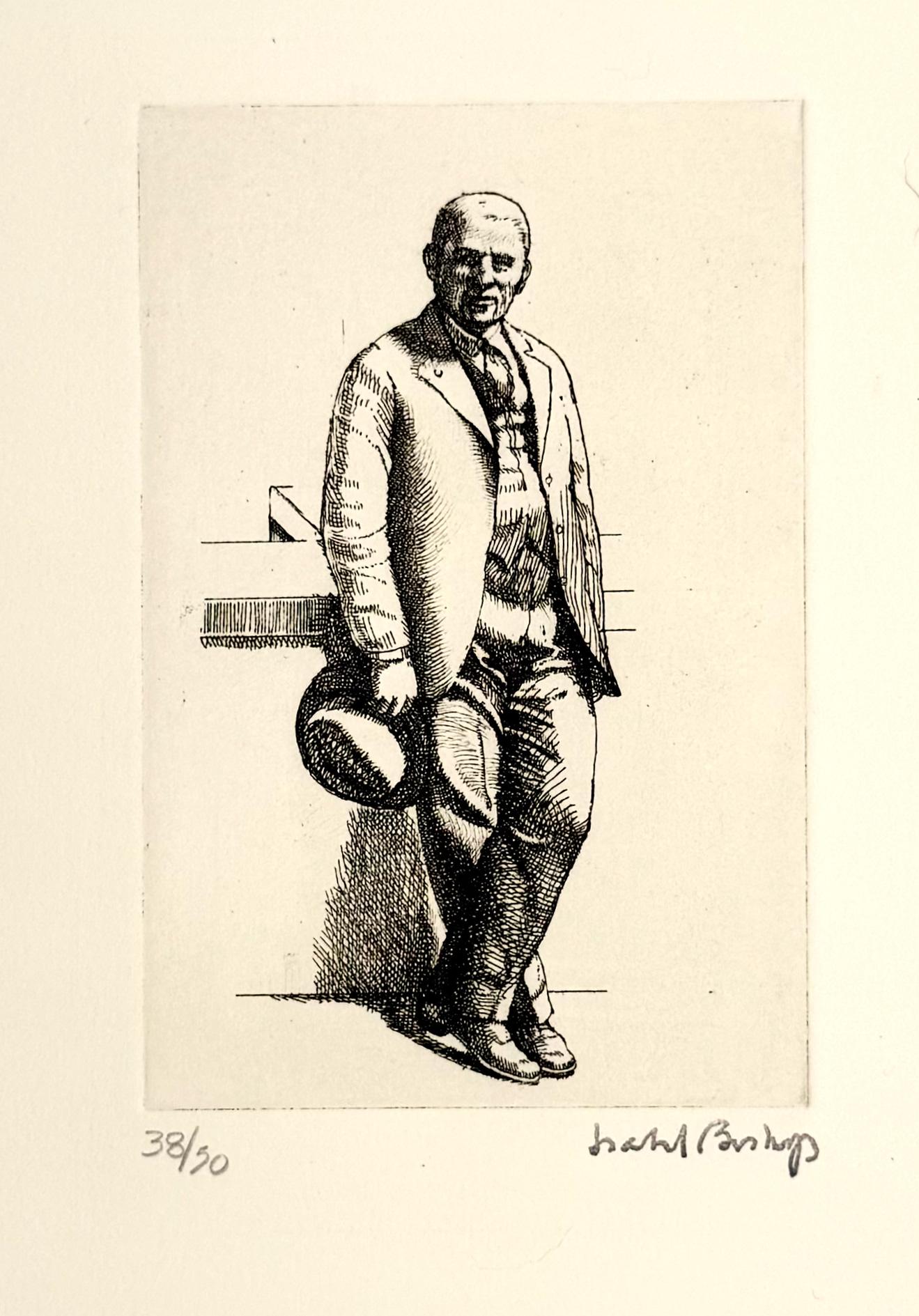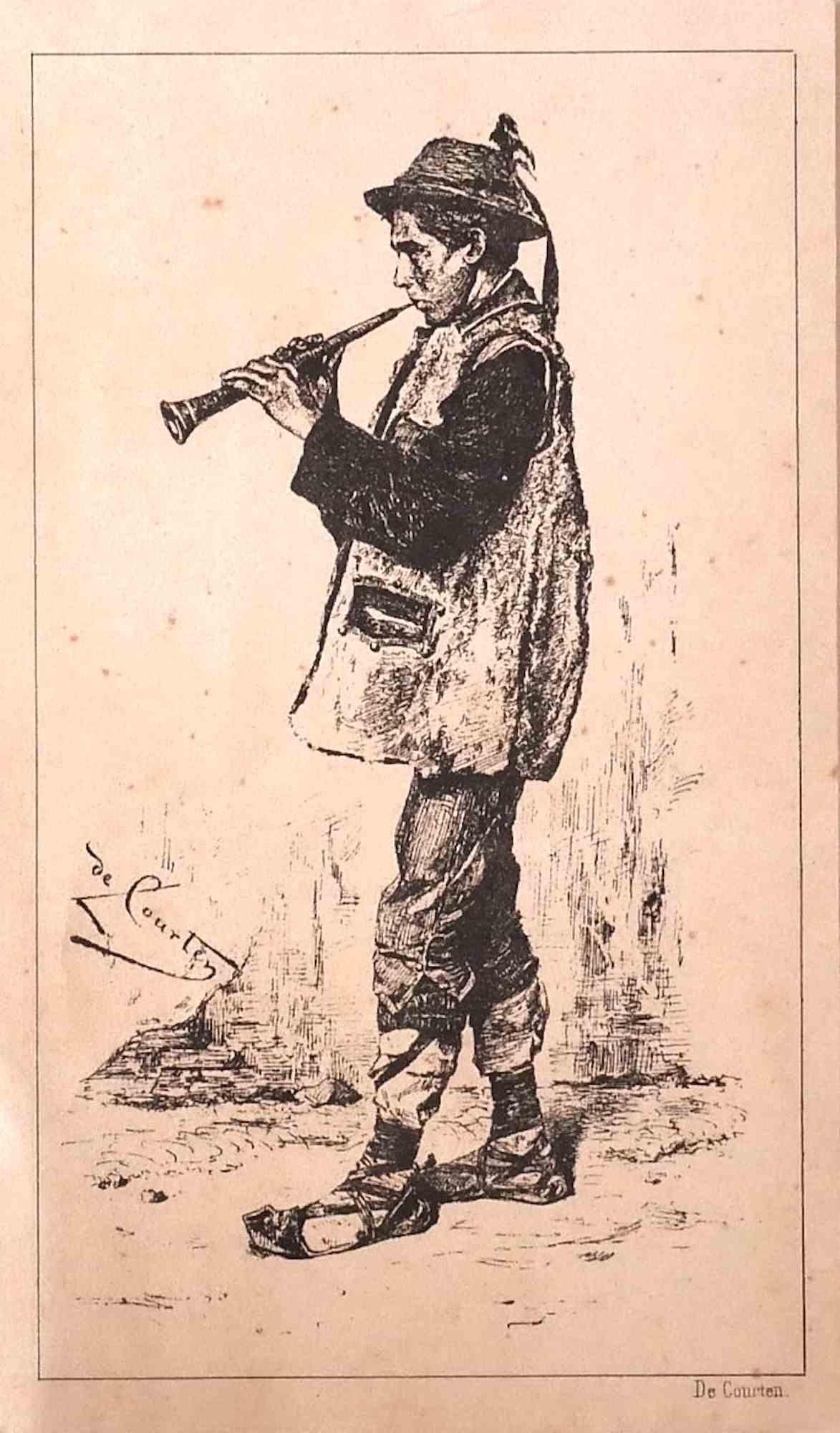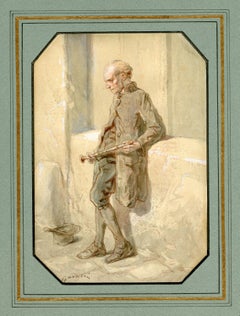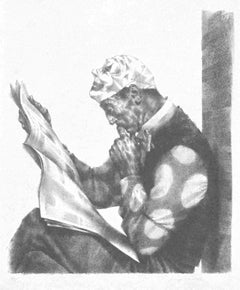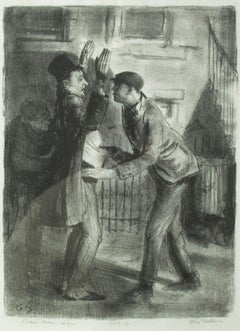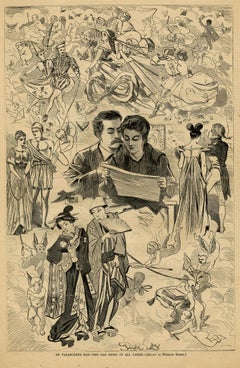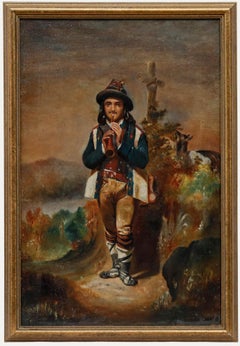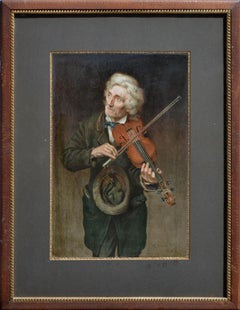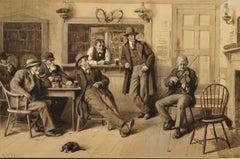Items Similar to The Fifer
Want more images or videos?
Request additional images or videos from the seller
1 of 6
Archibald WillardThe Fiferc. 1875
c. 1875
$2,500
£1,946.83
€2,214.52
CA$3,600.42
A$3,951.01
CHF 2,063.63
MX$47,238.69
NOK 26,139.54
SEK 24,380.04
DKK 16,539.34
About the Item
The Fifer
Etching, c. 1875
Unsigned
Provenance: Estate of the Artist
Bt descent in the artist's family
Edition: One of four known impressions
With annotation on the sheet in the artist's hand detailing the specifics of inking of the plate and tone of the ink.
Note: Depicts the Willard's friend, Hugh Mosher
An unrecorded etching by Willard based on his iconic Americana painting, The Spirit of '76. There are many documented versions of the painting, the most famous of which is in the Western Reserve Historical Society, Cleveland.
An online search of the following museums discovered no mention of this etching or examples in the following public collections:
Western Reserve Historical Society
Cleveland Museum of Art
Smithsonian Museum of American Art
Art Institute of Chicago
National Gallery of Art, Washington
Metropolitan Museum of Art, New York
Ohio Historical Society
New York Historical Society
Museum of Fine Arts, Boston
Massachusetts Historical Society
Harvard Art Museums
Yale University Art Gallery
Oberlin Art Museum
Columbus Art Museum
- Creator:Archibald Willard (1836 - 1918, American)
- Creation Year:c. 1875
- Dimensions:Height: 8.88 in (22.56 cm)Width: 6 in (15.24 cm)
- Medium:
- Movement & Style:
- Period:
- Condition:
- Gallery Location:Fairlawn, OH
- Reference Number:Seller: FA92591stDibs: LU14015487082
About the Seller
5.0
Recognized Seller
These prestigious sellers are industry leaders and represent the highest echelon for item quality and design.
Gold Seller
Premium sellers maintaining a 4.3+ rating and 24-hour response times
Established in 1978
1stDibs seller since 2013
827 sales on 1stDibs
Typical response time: <1 hour
Associations
International Fine Print Dealers Association
- ShippingRetrieving quote...Shipping from: Akron, OH
- Return Policy
More From This Seller
View AllUntitled (Musician with clarinet)
By Paul Gavarni (Guillaume Sulpice Chevalier)
Located in Fairlawn, OH
Untitled (Musician with clarinet)
Watercolor on paper, c. 1844
Created on J Whatman Turkey Mill Watermarked paper
Signed lower left: Gavarni (see photo)
Condition: very fresh colors
...
Category
1840s Romantic Figurative Drawings and Watercolors
Materials
Watercolor
Man with Mask
By Joseph Hirsch
Located in Fairlawn, OH
Man with Mask
Lithograph, 1969
Signed in pencil by the artist
95/100
Printed by Lucien Detruit, Paris
Published by AAA, New York
Reference: AAA Index No. 60
Condition: Mint
Image siz...
Category
1960s American Modern Figurative Prints
Materials
Lithograph
The Hold Up, First State
By George Wesley Bellows
Located in Fairlawn, OH
Signed in pencil by the artist lower right
Titled "Hold Up" by the artist in pencil.
Signed by the printer Bolton Brown lower left.
Edition: 42 in this state
Note: In The Hold Up, se...
Category
1920s American Realist Figurative Prints
Materials
Lithograph
St. Valentine's Day -- The Old Story in All Lands
By Winslow Homer
Located in Fairlawn, OH
St. Valentine's Day -- The Old Story in All Lands
Wood engraving, 1868
Published in: Harper's Weekly, February 22, 1868
Titled and signed in the block
Image size: 13 5/8 x 9 inches
C...
Category
1860s Hudson River School Figurative Prints
Materials
Engraving
Keying Up - The Court Jester
By William Merritt Chase
Located in Fairlawn, OH
Keying Up - The Court Jester
Etching with drypoint, 1879
Signed in the plate lower left corner (see photos)
Proof before engraved title and engraved names
Printed on thin light golden Japanese tissue paper
In the final state, with engraved titled and typeface engraved artist’s signature below the image
Condition: excellent
Plate size: 6-5/8 x 4-1/4"
According to Pisano, this image was very popular during Chase’s life. It is based on his famous painting, Keying Up-The Court Jester, in the collection of the Pennsylvania Academy of Fine Arts. The painting was created in Munich during the artist’s studies there. It was exhibited in the 1876 Centennial Exhibition in Philadelphia where it won a Medal of Honor and helped establish the artist’s reputation as a leading American painter.
Chase, always conscious of self promotion, created the etching and had numerous impressions printed. He sold them for a modest price to increase his fame. The etching was later published in Sylvester R. Koehler, American Art Review, September 1878. It was for this American Art Review printing that the engraved titled and type face signature below the image were added to the plate.
This example was part of a group of impressions that came down in the Chase family via his daughter Dorothy Bremond Chase, his third daughter. They were acquired at auction in a single auction lot, housed in a paper board folder. The consignor was Associated American Artist’s as they were liquidating their stock prior to closing the gallery.
Dorothy was the subject of Chase’s painting, My Little Daughter Dorothy. C. 1894, in the collection of the Detroit Institute of Arts as well as numerous other portraits of her.
Reference: Pisano/Bake, Volume 1, Pr. 3, illustrates the rare 1st state, this being a 2nd state before any other the engraved title and Chase's name in the bottom margin which are found in the third state.
Artist bio in file (Chase)
In 1883 Chase was involved in the organization of an exhibition to help raise funds for a pedestal for the Statute of Liberty. The exhibition featured loans of three works by Manet and urban scenes by the Italian Impressionist Giuseppe de Nittis. Both artists influenced Chase's Impressionistic style that gave rise to a series of New York park scenes. It is also thought that he was influenced by John Singer Sargent's In the Luxembourg Gardens (1879) which was exhibited in New York at this time. Indeed, Chase had met Sargent in Europe in 1881, the two men becoming lifelong friends with Sargent painting Chase's portrait in 1902.
On another European trip in 1885, Chase met James McNeill Whistler in London. While Whistler had a reputation for being difficult, the two artists got along famously and agreed to paint one another's portrait. Eventually, however, Whistler's moods began to grate with Chase who wrote home stating "I really begin to feel that I never will get away from here". For his part, Whistler criticized Chase's finished portrait and, according to Hirshler, "complained about Chase for the rest of his life". While no record exists of Whistler's portrait of Chase; Chase's portrait of Whistler remains a well-known piece in his oeuvre.
In 1887 Chase married Alice Gerson, the daughter of the manager of a lithography company. Though some fifteen years his junior (Chase was 37), he had known Alice for some time through her family's devotion to the arts. The pair, who would enjoy a happy marriage with Alice in full support of her husband's career, settled initially in Brooklyn where their first child was born. The couple would parent six daughters and two sons and it was only his family that could rival his devotion to his art. Indeed, Chase often combined his two loves by painting several portraits of his wife and children in Brooklyn parks before the couple relocated to Manhattan.
Later Period
Between 1891 and 1902, Chase and his family spent their summers at a purpose-built home and studio in Shinnecock Hills, a close suburb of the upmarket town of Southampton on the south shore of Long Island (roughly 100 miles east of New York). Chase set up, and taught two days a week, at the nearby Shinnecock Hills Summer School of Art which benefitted from the financial backing of local art collectors. It was at Shinnecock that Chase, taken in by the region's striking natural surroundings, painted several Impressionistic landscapes. As Bettis put it, "There, among the dunes, in the bright sunlight and sea air his painterly impulse was given free sway, and he produced some of his freest and loveliest work". His passion for the area was so felt he even gave his daughter Hazel the middle name of Neamaug, in honor of the rich Native American history of Shinnecock. Chase was equally focused on the students that came to the School and who he encouraged to paint in the modern plein air style favored by the French Impressionists.
Although Chase was making a name for himself as an Impressionist, he never abandoned his commitment to the sombre tones and academic tropes he had learned in Munich, though these he reserved for his portraits, and for his series of striking still lifes featuring dead fish. Chase was in fact a successful society portraitist - he painted fashionable women for a fee of $2,000 - and would paint his students as "samples" which he then donated to leading art institutions (such as Lady in Black (1888) which he donated to the Metropolitan Museum in 1891).
In 1896, facing financial difficulties, Chase flirted with the idea of giving up his teaching in New York and traveled with his family to Madrid where he developed a passion for bullfighting. Chase returned however to Shinnecock in June to teach his yearly summer art class, and in the fall of that year, established his own art school in Manhattan: the Chase School which was modelled on the Académie Julian in Paris. Chase lacked business savvy, however, and the Chase School lasted only two years before it was placed under new management. It continued as the New York School of Art (changed to Parsons School of Design starting 1941) with Chase as head the School for eleven more years. Chase also taught during this period at the Pennsylvania Academy of Fine Arts.
In 1902, following the premature death of his friend John Twachtman, Chase was invited to join the Ten American Painters group (who included amongst its members, Frank Weston Benson, Thomas Wilmer Dewing...
Category
1870s American Impressionist Figurative Prints
Materials
Etching
Man, Wife and Child
By John French Sloan
Located in Fairlawn, OH
Man, Wife and Child
Etching, 1905
Signed and titled in pencil by the artist below image (see photo)
Annotated in pencil by the artist "100 proofs"
Signed and dated in the plate lower...
Category
Early 1900s Ashcan School Figurative Prints
Materials
Etching
You May Also Like
Continental School Late 19th Century Oil - Shepherd Playing the Flute
Located in Corsham, GB
A charming late 19th-century oil portrait depicting a shepherd in traditional Tyrolean clothing, playing the flute in a mountain landscape. In the background, the artist captures a g...
Category
Late 19th Century Portrait Paintings
Materials
Oil
Old Violinist - Late 19th Century Figurative Lithograph
By John George Brown
Located in Soquel, CA
Finely detailed late 19th century chromo-lithograph portrait of a violinist street musician by John George Brown (British, 1831-1913). Many of Brown’s paintings were reproduced in lithography (Chromo-lithograpy), as is the case with the one offered here. Presented in a rustic antique Oak wood frame with giltwood fillet. Image, 15.63"H x 10.63"W.
John George Brown was a British citizen and an American painter born in Durham, England. His parents apprenticed him to the career of glass worker at the age of fourteen, in an attempt to dissuade him from pursuing painting. He studied nights at the School of Design in Newcastle-on-Tyne while working as a glass cutter there between 1849 and 1852, and evenings at the Trustees Academy in Edinburgh while working at the Holyrood Glass Works between 1852 ad 1853. After moving to New York City in 1853, he studied with Thomas Seir Cummings at the National Academy of Design where he was elected a National Academician in 1861. Brown was the Academy’s vice-president from 1899 to 1904.
Around 1855, he worked for the owner of the Brooklyn Glass Company, and later he married the daughter of his employer. His father-in-law encouraged his artistic abilities, supporting him financially, letting Brown pursue painting full-time. In 1866, he became one of the charter members of the Water-Color Society, of which he was president from 1887 to 1904. Brown became famous for his depictions of street urchins found of the streets of New York (bootblacks, street musicians, posy sellers, newsboys, etc.).
Brown’s art is best characterized as British genre painting...
Category
1870s Realist Portrait Prints
Materials
Paper, Lithograph
$463 Sale Price
20% Off
The Itinerant Fiddler
By Arthur Burdett Frost
Located in Fort Washington, PA
Date: 1890
Medium: Watercolor en Grisaille
Dimensions: 18.00" x 26.75"
Signature: Signed Lower Left
Editorial illustration, image of a man playing a violin with other men looking on...
Category
1890s Figurative Drawings and Watercolors
Materials
Watercolor
Man Holding Hat
By Isabel Bishop
Located in Middletown, NY
New York: Sylvan Cole, 1929.
Etching on white wove Rives paper with an infinity watermark, 5 15/16 x 3 15/16 inches (151 x 100 mm); sheet 15 7/16 x 11 15/16 inches (392 x 303 mm), f...
Category
1920s American Realist Portrait Prints
Materials
Drypoint, Aquatint
The Musician - Original Lithograph by Angelo De Courten - 19th Century
Located in Roma, IT
The Musician is an original Lithograph realized in the 19th Century by Angelo De Courten.
Good conditions.
The artwork is depicted through perfect hatching in a well-balanced compo...
Category
19th Century Modern Figurative Prints
Materials
Lithograph
Portrait of Scottish Gentleman with Clay Pipe - 18th century art oil painting
Located in Hagley, England
This atmospheric 18th century portrait oil painting is attributed to a Scottish artist. Painted circa 1790, The painting is a half length portrait of a seated gentleman. He is wearing a blue bonnet, the badge of a Scottish country gentleman and smoking a clay pipe. The way the light catches his hand and face and gleams on his buttons is lovely. The frame is super in that it echoes the button on his jacket. This is an excellent example of an 18th century Scottish portrait...
Category
17th Century Old Masters Portrait Paintings
Materials
Oil
$9,352 Sale Price
20% Off
